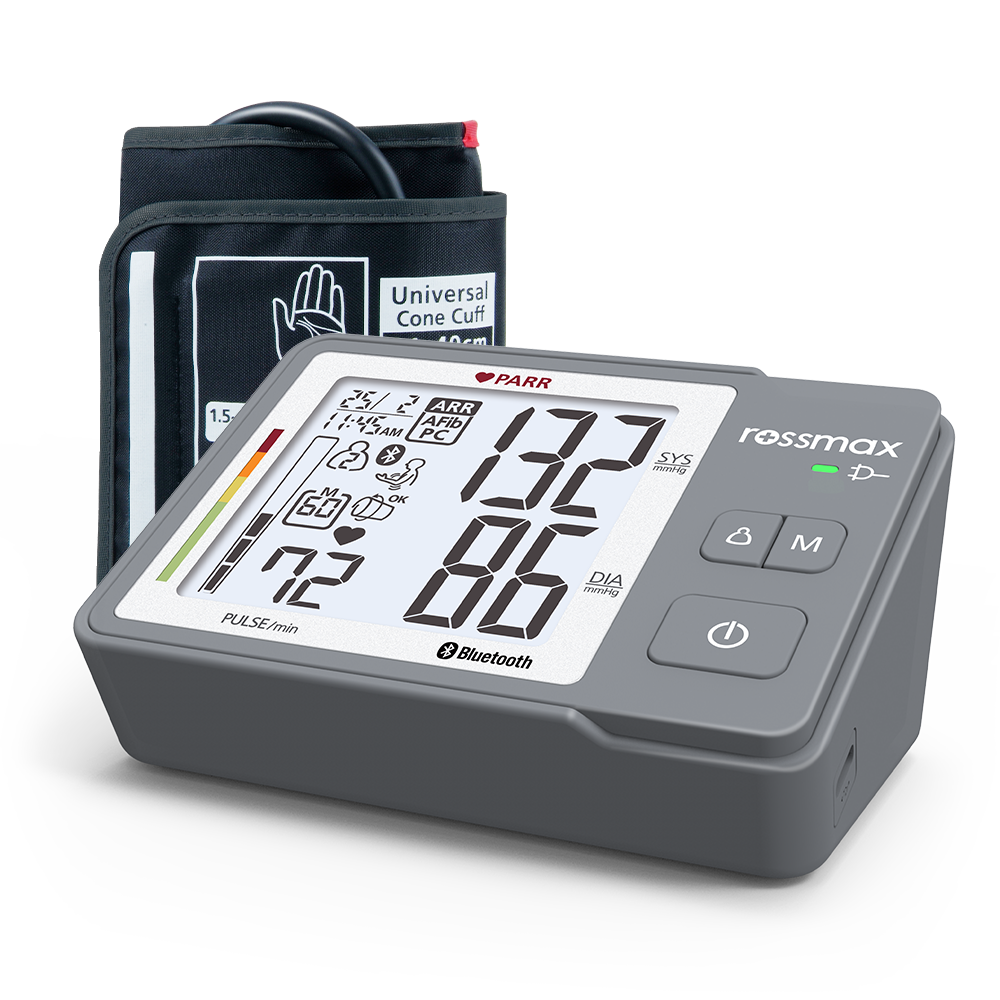High or low blood pressure?
See blood pressure reference values
ACCURATE MEASUREMENTS
High or low blood pressure? See blood pressure reference values
Blood flows in the veins of each person. It carries oxygen and nutrients to the cells as well as carbon dioxide and waste products out of the cells.
As a result of the pumping action of the heart, the amount of fluid in the bloodstream, and the resistance of the peripheral blood, the blood flows at a certain rate. We call this blood pressure and measure it using the millimetre of mercury (mmHg) as the unit of measurement.

Rossmax Z5/X5 Blood Pressure Monitor
Detects arrhythmia in connection with quick and easy blood pressure measurement, and accurately distinguishes between atrial fibrillation and extra beats.
Blood pressure readings matter.
Too high a reading is harmful to health in many respects, too low blood pressure can in turn cause embarrassing dizziness. Short-term fluctuations in blood pressure are normal.
| Blood Pressure Category | Systolic (mmHG) | Diastolic (mmHG) | |
| Normal | less than 120 | and | less than 80 |
| Pre-Hypertension | 120-139 | or | 80-89 |
| Stage 1 Hypertension | 140-159 | or | 90-99 |
| Stage 2 Hypertension | 160 or higher | or | 100 or higher |
Hypertension, or systolic pressure, refers to blood pressure when the heart contracts. Things that affect the increase in head pressure include:
-
increased left ventricular workload
-
stiffening of the aorta and large arteries and increased peripheral resistance
Vacuum, or diastolic pressure, measures blood pressure during the resting phase of the heart. Then the heart rests and fills with blood returning to the heart. The increase in vacuum is in turn affected by:
-
increased circulatory resistance
-
stiffening of the vessel wall
Age does not matter much either
The reference values for women and men are the same
Blood pressure reference values are the same for both men and women. Age does not matter much either, as only those over the age of 80 have a slightly higher target level.
At an ideal level, only 1/5 of the Swiss have a normal blood pressure. Blood pressure readings above the recommended values are clearly more common than values below them. More than two million Swiss have too high blood pressure.
High blood pressure is a very common problem in middle-aged and older people. Values generally begin to rise after the age of 40. Systolic blood pressure rises steadily with age. The negative pressure, on the other hand, slowly begins to decrease after the age of 50. Values generally begin to rise after the age of 40. It is common for older people to have primarily elevated pressure. This is because the walls of the arteries are stiffer. The negative pressure then often remains normal. An increase in vacuum is more common in young and middle-aged people, as they still have elastic artery walls.
High blood pressure is a very common problem in middle-aged and older people. Values generally begin to rise after the age of 40. Systolic blood pressure rises steadily with age. The negative pressure, on the other hand, slowly begins to decrease after the age of 50. Values generally begin to rise after the age of 40. It is common for older people to have primarily elevated pressure. This is because the walls of the arteries are stiffer. The negative pressure then often remains normal. An increase in vacuum is more common in young and middle-aged people, as they still have elastic artery walls.

An increase in vacuum is more common in young and middle-aged people.
High blood pressure predisposes to disease
High blood pressure should be treated, as if left untreated it can lead among others, to:
-
stroke
-
heart failure
-
myocardial infarction and
-
coronary heart disease.
For the brain, high blood pressure is a poison. As it prolongs, high blood pressure strains the brain, as the pressure brittles and greases the blood vessels in the brain. This exposes a person to cerebral infarction and cerebral hemorrhage, and the risk of cerebrovascular disorders increases manyfold.
Studies have suggested that when blood pressure is treated, it reduces memory problems.
The most common factors behind high blood pressure are poor lifestyle, hereditary causes or illnesses.
High blood pressure is caused by, among other things:
-
smoking
-
overweight, especially at the waist
-
abundant use of licorice and salmia products
-
little exercise
-
heavy use of NSAIDs such as ibuprofen and naproxen
-
stress
-
avoiding excessive stress
Sometimes high blood pressure is due to hereditary causes. About five percent of high blood pressure is due to disease. High blood pressure is caused by diseases associated with kidney function and adrenal dysfunction.
Reduces the risk of developing arterial disease
Low blood pressure is usually harmless
Low blood pressure usually does not cause harm. Rather, it is thought to be beneficial as it reduces the risk of developing arterial disease. Arterial disease means narrowing of the blood-carrying arteries, which impairs blood flow in the vein.

Exercise is also important to keep your blood pressure under control.
Effects of low blood pressure
vary with age
In healthy and young adults, an upper pressure of 100 mmHg or less is not harmful.
In the elderly, low blood pressure is usually caused by a disease related to blood vessels or heart, such as heart failure - or medicines taken to treat it.
Often, low blood pressure causes dizziness as a problem, which bothers especially when getting up and immediately after. Mild dizziness is usually not dangerous. It can be avoided by getting up at a very calm pace.
For example, in the morning you can get out of bed first to sit on the edge of the bed. It can wait half a minute to a minute for the pressure to level off. Only then should you stand up.
If dizziness persists for a long time, it is advisable to seek medical attention. There is no effective medication for low blood pressure. If you need to use antihypertensive medication for some other ailment, your doctor may look for a more suitable medication.
Although the use of salt raises blood pressure, increasing its use is not recommended for the treatment of low blood pressure. Excessive use of salt is otherwise harmful to health. If you suspect that your blood pressure is falling sharply when you get up, you can check with your home monitor. First, blood pressure is measured normally. Since then ascend to stand up and, after half a minute of standing blood pressure is measured again. If your blood pressure drops by 20 notches or more and gets dizzy when you get up, it’s probably because your blood pressure is too low.
When measuring blood pressure, it is worth noting that the automatic monitor may show a false low result if the heart rhythm is uneven. This may be due to atrial fibrillation, for example. A high-quality blood pressure monitor detects atrial fibrillation, so its measurement result is very reliable.
Although the use of salt raises blood pressure, increasing its use is not recommended for the treatment of low blood pressure. Excessive use of salt is otherwise harmful to health. If you suspect that your blood pressure is falling sharply when you get up, you can check with your home monitor. First, blood pressure is measured normally. Since then ascend to stand up and, after half a minute of standing blood pressure is measured again. If your blood pressure drops by 20 notches or more and gets dizzy when you get up, it’s probably because your blood pressure is too low.
When measuring blood pressure, it is worth noting that the automatic monitor may show a false low result if the heart rhythm is uneven. This may be due to atrial fibrillation, for example. A high-quality blood pressure monitor detects atrial fibrillation, so its measurement result is very reliable.
Too low blood pressure is very rare in children
Children's reference values are lower
Childhood includes the fact that blood pressure rises over the years. The ascent begins at the first year of age. The child's blood pressure is checked at the age of 4 at a medical examination at a children's clinic.
At the age of 8-9, blood pressure settles on average at the level prevailing in low-salt or salt-free communities. Thus, in childhood, blood pressure is lower than in adults, only in adolescence do the reference values rise to adult levels.
If the child has an upper pressure of more than 140 mmHg and a lower pressure of more than 90 mmHg, the situation requires further investigation. It is important to address high blood pressure, as prolonged exposure causes permanent organ damage and predisposes to even severe circulatory problems.
Hypertension is rare in children. Usually it is due to some disease. It can also be self-inflicted, meaning it is a primary hypertension. This typically occurs by family.
The treatment is primarily the treatment of the disease. In the treatment of primary hypertension, priority is given to
weight control
reduction of licorice and salmia intake
restriction of salt use
adding fruits and vegetables to the diet
exercise at least three times a week
medication
Too low blood pressure is very rare in children. If this happens, it is usually due to very little drinking, which has led to dehydration, or severe eating disorders such as anorexia.

